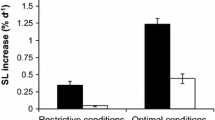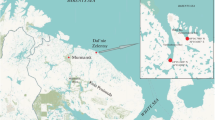Abstract
Since Mytilus edulis L. has very few predators and competitors for space, it has become a biomass dominant in the Baltic proper covering hard substrates from the water surface to more than 30 m depth. In order to investigate the factors controlling size and production in a Baltic M. edulis population, growth was studied by the analysis of annual growth rings, measurements of caged individuals and the analysis of size classes in the population, and on settlement ropes. The total number of mussels in a representative mussel bed at 4 m depth varied between 36 000 and 158 000 ind · m-2 during the year, mainly due to variations in very small mussels (<2 mm), whereas the abundance of mussels ≧2mm was rather constant between about 17 000 and 28 000 ind · m-2. Maximum numbes of mussels < 2 mm, amounting to 132 000 ind · m-2, were found after settlement in summer, but still half a year later in spring, 65 000 ind · m-2 < 2 mm were registered, due to very strong intraspecific competition for food and space leading to the competitive suppression of small individuals and large variations in growth rates. Due to the special size-structure of the population only the analysis of annual growth rings could be used to estimate natural shell growth. From being very low in the smallest mussels, growth was linear between about 2–10 yr of age, corresponding to about 3–20 mm length, after which it decreased with a L∞=32 mm. Over the linear interval, growth in the populations from 3–6 m and 10–15m depth was 3.1 and 2.2 mm · yr-1, respectively. Meat growth showed strong annual variations mainly due to gonad production. Starving mussels could, however, while utilizing energy reserves, survive losses of up to 78% of their meat biomass. This ability of M. edulis to “respire away its own biomass” and its apparent tolerance of weight loss has important implication. It will drastically reduce the energy flow to destruents from mussels dying naturally, which is of special significance in the Baltic, where predators and scavengers are scarce. It enables the mussels to endure bad food conditions and buffer strong seasonal variations in food abundance, maintaining the strongly food-and space-limited Baltic M. edulis population at the carrying capacity of the area.
Similar content being viewed by others
Literature Cited
Ankar, S.: Growth and production of Macoma balthica (L.) in a northern Baltic soft bottom. Ophelia, Suppl. 1, 31–48 (1980)
Ankar, S. and R. Elmgren: The benthic macro-and meiofauna of the Askö-Landsort area (Northern Baltic Proper). A stratified random sampling survey. Contrib. Askö Lab. Univ. Stockholm 11 1–115 (1976)
Bayne, B. L. and R. J. Thompson: Some physiological consequences of keeping Mytilus edulis in the laboratory. Helgoländer wiss. Meeresunters. 20, 526–552 (1970)
Bayne, B. L., J. Widdows and R. J. Thompson: Physiological integrations. In: Marine mussels, pp 261–299. Ed. by B. L. Bayne. Cambridge: Cambridge University Press 1976
Bayne, B. L. and C. M. Worrall. Growth and production of mussels Mytilus edulis from two populations. Mar. Ecol. Prog. Ser. 3, 317–328 (1980)
Boetius, I.: Temperature and growth of Mytilus edulis (L.) from the Northern Harbour of Copenhagen (The Sound). Medd. Dan. Fisk. Havunders., København, N.S. 3, 339–346 (1962)
Boje, R.: Die Bedeutung von Nahrungsfaktoren für das Wachstum von Mytilus edulis L. in der Kieler Förder und im Nord-Ostsee-Kanal. Kieler Meeresforsch. 21, 81–100 (1965)
Bouxin, H.: Observations sur le frai de Mytilus edulis var. galloprovincialis (Lmk) dates precises de frai et facteurs provoquant l'émission de produit génitaux. Rapp. P.-V. Réun. Cons. Int. Explor. Sci. Mer. Mediterr. 143, 43–46 (1956)
Brand von, T., P. Mc Mahon and M. O. Nolan: Physiological observations on starvation and desiccation of the snail Australorbis glabratus. Biol. Bull. mar. biol. Lab., Woods Hole 113, 89–102 (1957)
Dybern, B. I., H. Ackefors and R. Elmgren (eds.): Recommendation on methods for marine biological studies in the Baltic Sea. The Baltic Marine Biologists Publ. 1, 1–98 (1976)
Ebert, T. A.: Growth rates of the sea urchin Strongylocentrotus purpuratus related to food availability and spine abrasion. Ecology 49, 1075–1091 (1968)
Gartner-Kepkay, K. E., L. M. Dickie, K. R. Freeman and E. Zouros: Genetic differences and environments of mussel populations in the Maritime Provinces. Can. J. Fish. Aquat. Sci. 37, 775–782 (1980)
Harger, J. R. E.: Comparisons among growth characteristics of two species of sea mussel, Mytilus edulis and M. californianus. Veliger 13, 44–56 (1980)
Innes, D. J. and L. E. Haley: Genetic aspects of larval growth under reduced salinity in Mytilus edulis. Biol. Bull. mar. biol. Lab., Woods Hole 153, 312–321 (1977)
Jansson, A.-M. and N. Kautsky: Quantitative survey of hard bottom communities in a Baltic archipelago. In: Biology of benthic organisms. 11th Europ. Symp. Mar. Biol., Galway, Oct. 1976, pp 359–366. Ed. by B. F. Keegan, P. O'Ceidigh and P. J. S. Boaden. Oxford: Perg. Press, Oxford 1977
Jansson, B.-O., I. Wallentinus and F. Wulff: Östersjön—en livsmiljö i förvandling. Naturvetenskapliga forskningsrådets årsbok 1979/80 181–218 (1980)
Jørgensen, C. B.: Growth efficiencies and factors controlling size in some mytilid bivalves, especially Mytilus edulis L. Review and interpretation. Ophelia 15, 175–192 (1976)
Kautsky, N.: On the trophic role of the blue mussel (Mytilus edulis L.) in a Baltic coastal ecosystem and the fate of the organic matter produced by the mussels. Kieler Meeresforsch., Sonderh. 5, 454–461 (1981a)
Kautsky, N.: On the role of the blue mussel Mytilus edulis L. in the Baltic ecosystem. Thesis summary. Univ. Stockholm, Sweden 1–22 (1981b)
Kautsky, N.: Quantitative studies on the gonad cycle, fecundity, reproductive output and recruitment in a Baltic Mytilus edulis L. population. Mar. Biol. 68, 143–168 (1982)
Madsen, H.: A study of the littoral fauna of north west Greenland. Medd. Grønland 124, 1–24 (1940)
Mead, A. D.: The natural history of the star-fish. Bull. U.S. Fish. Comm. (1899) 19, 203–224 (1901)
Menge, B. A.: Competition for food between two intertidal starfish species and its effect on body size and feeding. Ecology 53, 635–644 (1972)
Milkman, R. and R. K. Koehn: Temporal variation in the relationship between size, numbers and an allele-frequency in a population of Mytilus edulis. Evolution 31, 103–115 (1977)
Mossop, B. K. E.: The rate of growth of the sea mussel (Mytilus edulis L.) at St. Andrews New Brunswich, Digby Nova Scotia and Hudson Bay. Transactions of the Royal, Canadian Institute 4, 3–21 (1922)
Muscatine, L.: Some aspects of the relationships between a sea anemone and its symbiotic algae. Diss., University of California, Berkeley 1–100 (1961)
Paine, R. T.: Natural history, limiting factors and energetics of the opisthobranch Navanax inermis. Ecology 46, 603–619 (1965)
Raymont, J. E. G.: The fauna of an intertidal mud flat. In: Papers in marine biology and oceanography. Deep Sea Research. Supp. 3, 178–203 (1955)
Remane, A. and C. Schlieper: Biology of brackish water. Wiley-Interscience, New York 1–372 (1971)
Reynolds, N.: The settlement and survival of young mussels in the Conway fishery. Fish. Invest. Min. Agric. Fish. Food, London, Ser. II 26, 1–24 (1969)
Richards, O. W.: The growth of the mussel Mytilus californianus. Nautilus 41, 99–101 (1928)
Sadykhova, I. A.: Some data on the biology and growth of Mytilus grayanus Dunker in experimental cages in Peter the Great Bay. Proc. Symp. Moll. 2, 431–435 (1967)
Samtleben, C.: Größenverteilungen von Populationen, Totengemeinschaften und Klappenansammlungen der Muschel Mytilus edulis L. Meyniana 23, 69–92 (1973)
Samtleben, C.: Klappenwachstum und Entwicklung von Größenverteilungen in Populationen von Mytilus edulis L. Meyniana 29, 51–69 (1977)
Schütz, L.: Die tierische Besiedlung der Hartböden in der Schwentinemündung. Kieler Meeresforsch. 20, 198–217 (1964)
Seed, R.: Factors influencing shell shape in Mytilus edulis L. Mar. Biol. Assoc. United Kingdom 48, 561–584 (1968)
Seed, R.: The ecology of Mytilus edulis L. (Lamellibranchiata) on exposed rocks shores. 2. Growth and mortality. Oecologia 3, 317–350 (1969)
Seed, R.: Ecology. In: Marine mussels, pp 13–65. Ed. by B. L. Bayne. Cambridge: Cambridge University Press, Cambridge 1976
Theisen, B. F.: Shell cleaning and deposit feeding in Mytilus edulis L. Ophelia 10, 49–55 (1972)
Theisen, B. F.: The growth of Mytilus edulis L. (Bivalvia) from Disko and Thule district, Greenland. Ophelia 12, 59–77 (1973)
Ursin, E.: On the incorporation of temperature in the von Bertalanffy growth equation. Medd. Dan. Fisk. Havunders., N.S. 4, 1–16 (1963)
Walford, L. A.: A new graphic method of describing growth of animals. Biol. Bull. 90, 141–147 (1946)
Wallace, J. C.: Growth rates of different populations of the edible mussel Mytilus edulis in north Norway. Aquaculture 19, 303–311 (1980)
Warren, C. E. and G. E. Davis: Laboratory studies on the feeding bioenergetics and growth of fish. In: The biological basis of freshwater fish production, pp 175–214. Ed. by S. D. Gerking. Oxford: Blackwell Scientific Publications, Oxford 1967
Whedon, W. F.: Spawing habits of the mussel Mytilus californianus with notes on the possible relation to mussel poison. University of California Publications in Zoology 41, 35–44 (1936)
Wilson, B. R. and E. P. Hodgkin: A comparative account of the reproductive cycles of five species of marine mussels (Bivalvia; Mytilidae) in the vicinity of Freemantle, W. Australia. Australian Journal of Marine and Freshwater Research 18, 175–203 (1967)
Winberg, G. G.: Methods for the estimation of production of aquatic animals. Academic Press. London and New York 1–175 (1971)
Author information
Authors and Affiliations
Additional information
Communicated by O. Kinne, Hamburg
Rights and permissions
About this article
Cite this article
Kautsky, N. Growth and size structure in a baltic Mytilus edulis population. Mar. Biol. 68, 117–133 (1982). https://doi.org/10.1007/BF00397599
Accepted:
Issue Date:
DOI: https://doi.org/10.1007/BF00397599




